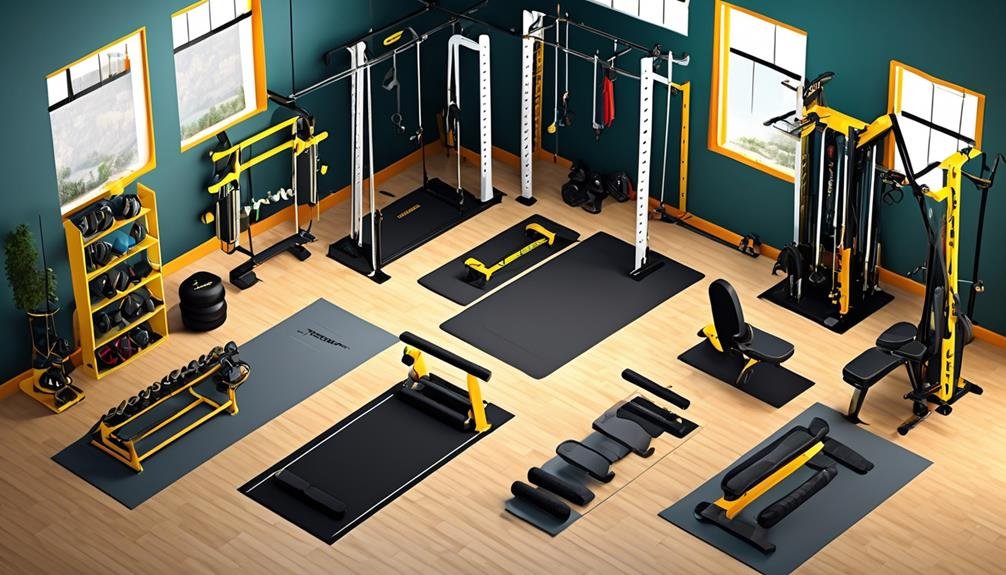So you're hitting the gym, ready to tackle those strength training reps and build some serious muscle. But have you ever stopped to consider how you're breathing during those intense workouts? It may seem like a small detail, but proper breathing technique can actually make a big difference in your performance and results.
In fact, it can be the key to unlocking your full potential in the weight room. But what exactly is the proper way to breathe during strength training reps? Well, get ready to take a deep breath and discover the secrets to maximizing your gains.
Key Takeaways
- Proper breathing technique is crucial for maximizing strength training reps and achieving optimal results.
- Holding your breath during strength training can increase blood pressure and limit oxygen to muscles.
- Inhaling before the eccentric part of the motion and exhaling during the concentric part allows for efficient muscle contraction and engagement.
- Rhythmic breathing, avoiding breath holding, and engaging the diaphragm through deep breaths are essential for safety and effectiveness in strength training.
The Importance of Proper Breathing Technique
Proper breathing technique is essential for maximizing your strength training reps and achieving optimal results. When it comes to strength training, many people tend to hold their breath without realizing the negative impact it can have on their performance. By exhaling during the exertion phase and inhaling during the relaxation phase, you can significantly improve your workout.
During strength training exercises, it's important to maintain a steady flow of oxygen to your muscles. Holding your breath can cause an increase in blood pressure and limit the amount of oxygen reaching your muscles. This can lead to fatigue and a decrease in your lifting capacity. By exhaling during the exertion phase, you allow your muscles to contract more efficiently and engage all your muscles fully.
On the other hand, inhaling during the relaxation phase helps to replenish oxygen levels and remove waste products, such as carbon dioxide, from your muscles. This not only improves blood circulation but also enhances your overall cardiovascular health. By adopting the proper breathing technique, you can maximize your workout and improve your overall fitness level.
One technique commonly used in strength training is the Valsalva maneuver. This involves taking a deep breath and holding it during the exertion phase. While this technique can provide temporary stability, it's important to note that it can be risky, especially for those with high blood pressure or heart conditions. Therefore, it's recommended to consult with a fitness professional or trainer to determine the most suitable breathing technique for your specific needs.
Breathing Patterns for Strength Training
To optimize your strength training performance, it is crucial to understand the proper breathing patterns that will enhance your workout efficiency and maximize your results. Breathing technique plays a significant role in engaging all muscles, increasing lifting capacity, and improving overall health and well-being during strength training. Here are some practical breathing patterns to incorporate into your workouts:
| Breathing Pattern | Technique |
|---|---|
| Inhale | Inhale deeply through your nose before starting the eccentric part of the motion. This helps prepare your body for the upcoming exertion and allows for optimal oxygen uptake by the muscles. |
| Hold | Avoid holding your breath during weightlifting. Holding your breath can raise blood pressure and potentially lead to dizziness or even a heart attack. Instead, focus on maintaining rhythmic breathing throughout the exercise. |
| Exhale | Exhale completely through your mouth during the concentric part of the motion. This helps release carbon dioxide and engage the core, enhancing overall stability and control during the lift. |
Inhaling and Exhaling: Timing and Rhythm

Inhaling and exhaling with proper timing and rhythm is essential for maximizing your strength training performance. The way you breathe during each rep can greatly impact your ability to generate power and maintain stability. Here are some key points to keep in mind:
- Inhale through your nose: Taking a deep breath through your nose before starting a rep allows you to fill your lungs with oxygen and engage your diaphragm. This helps stabilize your core and prepare your body for the movement.
- Exhale as you extend: As you push or lift the weight, exhale forcefully through your mouth. This helps activate your core muscles and increase your power output. It also helps maintain proper form and prevent unnecessary strain on your body.
- Breathing control throughout the exercise: It's important to maintain control over your breathing throughout the entire set. Avoid holding your breath, as it can increase blood pressure and restrict oxygen flow. Instead, focus on rhythmic breathing, matching your inhales and exhales with the movement of the exercise.
Mouth Vs. Nose Breathing: Which Is Better?
When it comes to breathing during strength training reps, understanding the difference between mouth and nose breathing is essential for optimizing your performance. The general rule of thumb is to inhale through your nose before the eccentric part of the motion and exhale completely through your mouth during the concentric part. This technique allows you to engage all your muscles and increase your lifting capacity.
It's important to avoid holding your breath while lifting, as this can raise your blood pressure and potentially lead to dizziness or even a heart attack.
Engaging your diaphragm and practicing deep breathing is crucial for safety and effectiveness during your training program. Deep breaths not only lower your blood pressure but also enhance relaxation, improving oxygen uptake by your muscles and optimizing the exchange of oxygen and carbon dioxide in your body. By breathing properly, you make exercise easier to perform and ensure that all your muscles are getting the necessary oxygen to perform at their best.
For beginners to resistance training, it may be helpful to exaggerate your breathing until you get the hang of inhaling and exhaling at the right times. Remember, mastering the correct breathing technique is a skill that can enhance your workout efficiency and overall performance.
Avoiding Common Mistakes in Breathing

To avoid common mistakes in breathing during strength training reps, it's important to understand the proper technique. Here are some tips to help you breathe correctly and maximize your training:
- Inhale through your nose before the eccentric part of the motion:
- Breathing in through your nose helps to activate your diaphragm and prepare your body for the upcoming movement.
- This allows for better oxygen uptake and can help increase your overall performance.
- Exhale completely through your mouth during the concentric part of the motion:
- Exhaling forcefully through your mouth helps to engage your core muscles and provide stability during the exercise.
- It also helps to release any tension or stress in your body.
- Avoid holding your breath:
- Holding your breath during weightlifting can lead to a rise in blood pressure and may even increase the risk of dizziness or heart attack.
- Remember to maintain a steady breathing pattern throughout your reps to ensure a safe and effective workout.
Benefits of Proper Breathing During Reps
Proper breathing during strength training reps not only helps avoid common mistakes but also offers a range of benefits that can enhance your overall exercise performance. When you breathe correctly during your reps, you experience improved muscle control and alertness, leading to better execution of each movement. Engaging all your muscles effectively allows you to increase your lifting capacity and gain more strength over time. Additionally, proper breathing reduces the need for excess air during exercise, leading to improved breathing efficiency and less carbon dioxide production.
Not only does proper breathing improve your physical performance, but it also has positive effects on your cardiovascular health. By ensuring you take deep breaths and exhale fully, you improve blood circulation and strengthen your heart. This contributes to your overall physical well-being and makes your workouts more effective.
To make sure you're reaping the benefits of proper breathing, there are a few things you can keep in mind. Firstly, focus on your breath and avoid holding it. Remember to inhale during the easier portion of the exercise and exhale during the more challenging part. Secondly, when performing moves to tone and strengthen your core, engaging your breath can help activate your deep abdominal muscles. Lastly, if you find yourself struggling to breathe while lifting heavy weights, consider lowering the weight to maintain proper form and breathing technique.
Practical Tips to Improve Breathing Technique

Improve your breathing technique during strength training reps with these practical tips:
- Inhale through the nose before the eccentric part of the motion and exhale completely through the mouth during the concentric part. This allows for better oxygen flow and helps you maintain control throughout the movement.
- Avoid holding your breath during weightlifting, as it can raise blood pressure and lead to dizziness or even a heart attack. Instead, focus on maintaining a steady rhythm of inhaling and exhaling to keep your blood pressure stable.
- Engage your core for stability by activating the abdominal muscles to create a brace for safe and effective lifting. This not only helps with proper breathing, but also provides support for your spine and helps you maintain good form throughout the exercise.
Enhancing Performance and Results With Correct Breathing
Enhance your performance and achieve optimal results in strength training by mastering correct breathing techniques. Proper breathing during strength training reps can have a significant impact on your overall performance and the results you achieve. By focusing on your breathing, you can enhance your performance and maximize the benefits of your workouts.
The proper way to breathe during strength training reps is to inhale through your nose before the eccentric part of the motion and exhale completely through your mouth during the concentric part. This rhythmic breathing pattern not only optimizes the function of your nervous system but also engages your diaphragm for efficient oxygen delivery to your muscles.
By avoiding holding your breath during weightlifting, you can prevent a dangerous rise in blood pressure and reduce the risk of internal injuries. Additionally, proper breathing techniques improve muscle control, increase your lifting capacity, and optimize the exchange of oxygen and carbon dioxide in your body.
For beginners, prioritizing proper breathing technique is crucial to enhancing overall program performance and minimizing the risks associated with breath-holding. By incorporating correct breathing into your strength training routine, you can enhance your performance, improve your results, and ensure a safer and more effective workout.
Frequently Asked Questions
How Do You Breathe When Doing Reps?
You breathe in through your nose before the movement and exhale through your mouth during the movement. Avoid holding your breath during weightlifting to prevent high blood pressure and dizziness.
What Is the Proper Breathing Technique While Strength Training?
To breathe properly during strength training, inhale through your nose before lowering the weight and exhale through your mouth as you push it up. This helps supply oxygen to your muscles and improves performance. Avoid holding your breath, as it can be harmful.
Should You Breathe in or Out on Reps?
Breathe out on the exertion and breathe in on the relaxation. This technique helps stabilize your core and maintain proper form. It also ensures sufficient oxygen supply to your muscles, improving performance and reducing the risk of dizziness.
Should I Hold My Breath During Reps?
Don't hold your breath during reps. Inhale through your nose before the hard part, then exhale through your mouth during the exertion. Proper breathing helps with performance and keeps you safe.
Conclusion
In conclusion, proper breathing technique is essential during strength training to optimize muscle control, increase lifting capacity, and enhance blood circulation. Remember to inhale during the eccentric phase and exhale during the concentric phase. Avoid holding your breath to prevent potential health risks.
By practicing correct breathing techniques, you can maximize the effectiveness of your workouts and reduce the risk of injury. Focus on improving your breathing rhythm and consider whether mouth or nose breathing works best for you.
Keep these tips in mind to enhance your performance and achieve better results in your strength training.





